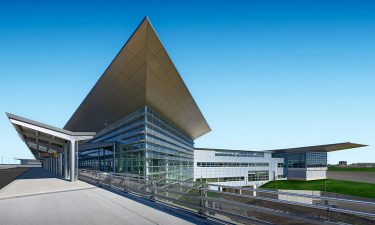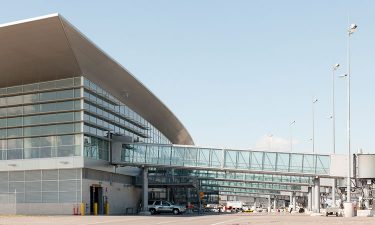A strong technology foundation has the potential to transform air travel
- Like
- Digg
- Del
- Tumblr
- VKontakte
- Buffer
- Love This
- Odnoklassniki
- Meneame
- Blogger
- Amazon
- Yahoo Mail
- Gmail
- AOL
- Newsvine
- HackerNews
- Evernote
- MySpace
- Mail.ru
- Viadeo
- Line
- Comments
- Yummly
- SMS
- Viber
- Telegram
- Subscribe
- Skype
- Facebook Messenger
- Kakao
- LiveJournal
- Yammer
- Edgar
- Fintel
- Mix
- Instapaper
- Copy Link
Posted: 17 February 2020 | Tara Nolan (International Airport Review), Trevor Strome | No comments yet
Winnipeg Airports Authority’s Trevor Strome details the importance of up-to-date IT infrastructure; providing a vision for the future of airport technology.


With the range of technologies and IT infrastructures currently available to the aviation industry, the consequent applications, benefits and opportunities are of course varied.
International Airport Review’s Airport IT & Security 2020 conference provides a platform for these industry innovations to be explored, explained, discussed and debated, including an exclusive workshop hosted by Trevor Strome.
As Winnipeg Airports Authority’s Director of Digital Airport Solutions, Strome’s knowledge of strategic applications of digital technology, data analytics and process re-engineering is well equipped to help airports generate new insights and drive excellence in quality and system performance. International Airport Review spoke to Strome to gather an insight into how digital tools have so far been implemented at Winnipeg.
What are your current and future priorities for IT at the Winnipeg Airports Authority?
Current priorities for our Information Technology team include ensuring we are provisioning a secure, stable and up-to-date environment to support the smooth function of business and airport operations. One focus of this effort is the upgrading of key hardware and software systems that are nearing, or are at, their end-of-life. This includes upgrading our workstations and servers to the most up-to-date versions of operating systems.


We have also just completed a major update of our on-premise server and core network infrastructure and are in the process of commissioning and migrating systems to the new hardware. Several of our key airport-specific systems (such as our AODB) and corporate information systems (such as our Asset Management and ERP systems) are also undergoing version upgrades.
On the cyber front, we are continually enhancing our cyber-security tools, policies and procedures to help reduce our cyber-risk and improve our response to suspicious and/or malicious behaviour on our systems and/or networks.
Which area of the operation has benefited the most from the evolution of technology?
Although the rapid pace of technological evolution is impacting almost every corner of the airport, one of the areas undergoing very rapid change is in our data integration and analytics capabilities.
Over the past two years, we have been building our Data Operations (DataOps) team and capabilities. Through the DataOps team, we are creating an Integration and Analytics Centre of Excellence within the organisation to provide accurate, timely and readily available information, as well as analytical expertise and the requisite tools, to stakeholders in support of efficient and effective decision-making. Our goal is to enable ‘self-serve’ analytics, meaning stakeholders throughout our organisation would have the ability to build their own dashboards and develop their own analytics using a standardised and supported set of tools; pulling trusted, curated data from a single ‘source of truth’. Even though it is early days in the programme, we have seen analysts’ productivity dramatically increase; what was once cumbersome work due to the limitations of spreadsheets is now easier, quicker and likely to generate more insight due to the power in modern business intelligence and analytic tools.
On 19 October, Trevor Strome will host a unique workshop at Munich Airport’s ISH. As part of Airport IT & Security 2020, this workshop will delve into the data applications, IT opportunities and digital tools available to airports.
The most competitive airports will continually discover unique ways to improve efficiency, create new products and services, and potentially transform air travel
What are the biggest lessons learned of integrating new IT systems?
The latest generation of integration tools support Application Programming Interface (API)-based application integrations in near real time between on-premise systems, or in a hybrid configuration (i.e., between on-prem systems and those that exist on the cloud). As more systems used by airports are cloud-based, API-based integrations become vital as such integrations may be the only way to access the organisation’s data from those cloud-based hosts.
Winnipeg Airports Authority have recently adopted an Integration Platform as a Service (iPaaS) to assist with API-based on-prem and hybrid application integrations and movement of some source system data (especially that which is situated on the cloud) to our Enterprise Data Warehouse (EDW). We have found that modern integration tools are very highly configurable and robust; the ‘low-code/no-code’ options allow for individuals with a broader range of skills (including business intelligence specialists and business analysts) rather than just developers with specialist skills in integration to build integrations of impressive complexity. With the iPaaS, we are now able to publish API’s for internal use (such as when various systems or dashboards need to pull data from the EDW). We are also planning to use the iPaaS to publish APIs to support access to our airport data by third parties outside the WAA (for example, pushing parking spot availability to our new website currently in development).
Winnipeg Airports Authority is building a strong technology foundation now so that we are ready to adopt and create innovations
The ability to connect with source systems via API is now almost requisite for any new systems that we are considering procuring. Most cloud-based vendors now offer API-based integrations that are compatible with common protocols (i.e., REST and SOAP), and even systems that are situated on-prem (such as building management solutions) offer the ability to connect via API. Modern iPaaS solutions also offer convenient integration performance monitoring tools to assist us in determining if a broken business process or workflow across disparate systems is the result of an integration-related issue, or a problem elsewhere.
How do you see airport IT further developing in the future?
WAA is looking into optimising and possibly automating airport-related and corporate processes using various technologies, including Robotic Process Automation (RPA). As an emerging technology, RPA has the potential to automate the most manual and repetitive tasks enabling our employees to focus on more rewarding, value-added and problem-solving related tasks. Currently we are working with our Finance Department to identify what current processes are possible candidates for optimisation and automation, and will shortly be conducting proofs-of-concept to demonstrate the feasibility of deploying RPA in the WAA environment. Lessons learned from these initial phases will help guide potential future deployment of RPA-related technologies more broadly throughout our organisation.


Airports will only continue the digitalisation trend, and the most competitive airports will continually discover unique ways to improve efficiency, create new products and services, and potentially transform air travel. In this light, a key priority for our team is to enable experimenting with technology and supporting innovation across the organisation. A key area of focus will be those technologies and innovations that help to improve customer experience and passenger flow and that lead to more efficient airport operations. Like many airports, we are looking closely at how biometrics (and even digital travel credentials) will transform the passenger experience as we edge closer to making seamless travel a reality. We are also exploring the use of systems and tools that incorporate artificial intelligence (such as video analytics systems) with various technology partners to analyse, and optimise, passenger flow, customer experience and even aircraft turn-around times. In a similar vein, we are exploring use of robotics (including an autonomous wheelchair and an autonomous snow plough) to help achieve these same goals.
There is no doubt that technology will figure prominently in the future of air travel, and the Winnipeg Airports Authority is building a strong technology foundation now so that we are ready to adopt and create innovations that not only benefit our travelling customers, but our community partners as a whole.
Trevor will be joined by over 400 attendees at Airport IT & Security 2020, including C-suite airport executives and IT experts. Make sure you join them in Munich by securing a ticket now.
Related topics
Autonomous Technology, Cyber-security, Information technology (IT), New technologies, Terminal operations


















